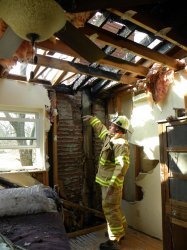With no tile liner there is little protection from the heat that will come off of the liner. An insulated liner will greatly improve the safety of this installation.
Ok, I'm missing something again... What am I protecting from the heat of the pipe? It's going to be inside a chimney that's designed to burn open fires. The chimney will be swept prior to installing. What am I missing?


